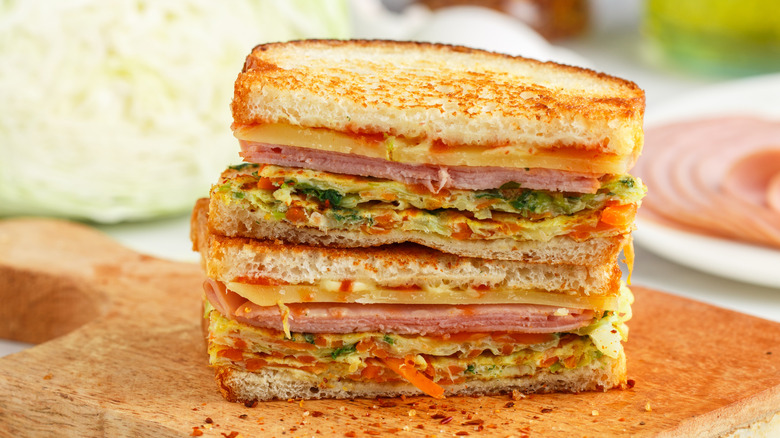This Famous South Korean Breakfast Sandwich's Key Ingredient Is A Big Sprinkle Of Sugar
Around the world, South Korea has become renowned for hosting some of the best street food eats. Its famous classics that can now be found globally, like the Korean corn dog (which is very distinct from its American counterpart) or spicy tteokbokki, the chewy, gelatinous rice cakes that are typically served in a spicy gochujang-based sauce and were famously featured in "Squid Game." To international foodies, one lesser-known South Korean street-food delicacy is gilgeori toast, a Korean street toast with cabbage and egg. Think French toast but with a little extra Korean-style flair. One ingredient that makes this beloved street food so special is sugar, which gives the sandwich its distinctive sweet-and-savory taste.
As is true with many great street foods, gilgeori toast is made up of delicious yet simple ingredients. Between two pillowy slices of buttered, toasted milk bread sits a cabbage, carrot, and green onion omelet. This omelet is then topped with a sprinkle of white sugar. Optional add-ins are luncheon-style ham (or Spam, which is actually a common food in South Korea) and a slice of cheese. You can use any cheese to suit your preference. For melting power, we recommend American. If you're going for a sharp flavor, cheddar has got you covered. For a more traditional Korean street-food flavor, you've got to go with mozzarella. South Koreans are in love with it, adding it on top of instant ramen, inside corn dogs, and even on buldak (spicy chicken). Not only is it delicious, but it will give you an insane cheese pull, too.
What are the origins of gilgeori toast?
Like many of South Korea's most famous street foods, gilgeori toast emerged from a unique blend of history, popular demand, and working-class culture. The Korean word "gilgeori" literally means "street," so the name translates simply to "street toast." Some ingredients can be traced back to Western influence, particularly processed meats like Spam, which were introduced by American soldiers during the Korean War. Much like the origins of Korean fried chicken, these imported foods were embraced by locals in the postwar years and gradually woven into the everyday food culture of South Korea.
There's no definitive date on the creation of gilgeori toast, but it's believed to have taken shape in the 1970s. Street kiosks and morning stalls began offering it as a cheap, filling option for locals. This was a great era for Korean culinary excellence, and the same time period as when icons such as Korean corn dogs and tteokbokki were introduced to the food scene. In the 2000s, Korean entrepreneurs turned the concept of "street toast" into chains that rapidly spread across Seoul. You've got iconic spots like Isaac toast, which started as a small kiosk in 1995 and now boasts over 800 branches across Korea, with international expansion already underway. You can even find Korean toast spots in London, and these are often accompanied by long lines. As it's becoming more available globally, gilgeori toast is solidifying its place as a true Seoul staple and a quintessential part of Korean street food culture.


